February 7 - 13, 2016: Issue 250
In Surf Life Saving Carnival Season: A Glance at Surf Carnivals in February 1909, 1919, 1925, a Fancy Dress Rise of Venus and Saving Lives with Surfboards
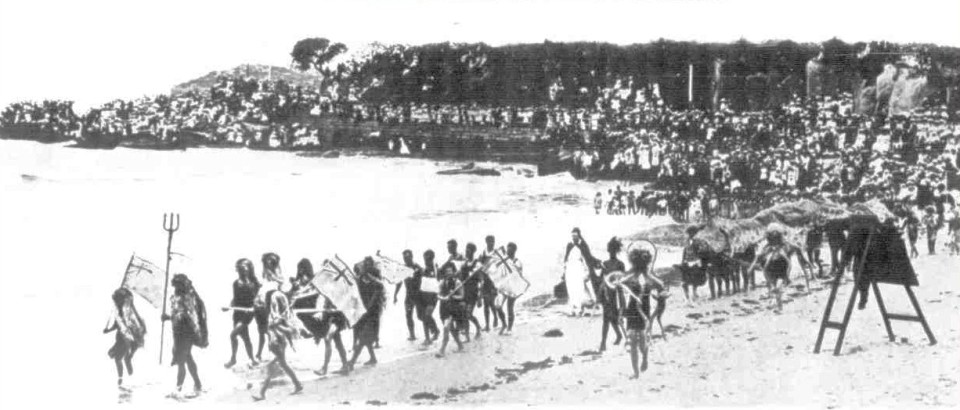
THE GREAT SURF CARNIVAL AND WATER FROLIC, " THE BIRTH OF VENUS,''' WHlCH TOOK PLACE AT MANLY SYDNEY ON SATURDAY LAST (L C Miller photo (?)). (1909, February 6). The Australasian (Melbourne, Vic. : 1864 - 1946), p. 34. Retrieved from http://nla.gov.au/nla.news-article139688072
In the coming week the Surf Life Saving Sydney Northern Beaches will hold its Branch events, a favourite of many, at Palm Beach. Yesterday, Saturday February 6th, the Masters Beach events and Lifesaving took place. Today, Sunday the 7th, the Westfield Warringah Mall Junior Branch Championships are scheduled. Next Saturday, 13th February, the Opens and Boats, Masters water events and R&R will be run.
For boaties the ASRL Open is on the 19 to 21 February at Shellharbour, while the Summer of Surf Round 8 will be hosted by Newport on Saturday 20th and Sunday 21st of February.
New South Wales State competitions will be hosted again in 2016 by Ocean Beach and Umina the last weekend of February and until mid March.
The Beko Best of the Best for surf boats, hosted by Surf Life saving New South Wales, will take place at North Narrabeen on April 2nd.
The Australian Surf Life Saving Championships 2016 (The Aussies) will be held on the Sunshine Coast from Saturday 16 April to Sunday 24 April 2016.
There are others, run through great local and further away surf life saving clubs, but you get a little of the picture – December, January, February, March and April are most definitely surf life saving carnival and competition season.
Surf Life Saving carnivals started with a total ‘all in’ ethos with Navy training cadets and vessels and Surf Bathers club included. Some of these characters on display during carnivals such as the 1909 ‘Rise of Venus’ fancy dress as part of that Manly Carnival would be rightly considered inappropriate today – the inference was on fun though, on showcasing what the surf life savers did and on promoting what was in these formative years, and remains, THE community organisation that most Australians are either members of or associated with as lifesavers who are part of voluntary patrols, as officials, as researchers to develop better ways to deal with everything from rips to safety equipment improvements, as officials, surf sports developers, coaches, swim overseers, equipment managers, Safety equipment such as IRB’s operators, first aid teachers and testers, as educators and trainers, as parents of Nippers, as supporters, as fans.
When you research ‘organisation that saves most lives each year in Australia’ it is Surf Life Saving Australia that appears at the top. This is what saves lives or prevents the loss of life each year.
2013 statistics state the organisation had '166,923 members with 311 affiliated surf life saving clubs, making it reputably the largest volunteer movement of its kind in Australia’ and ‘services are provided by volunteer lifeguards, called surf lifesavers, that provided 1.4 million hours of service, rescued 11,533 people, and provided 64,645 first aid treatments during 2013. In 1973, the organisation established the Westpac Life Saver Rescue Helicopter Service that, during 2013, delivered 1,300 rescue missions via helicopter.’
The 2014-2015 SLS Annual report states 1, 255, 090 preventative actions were taken, 42, 424 First Aid Treatments and 12, 690 rescues. By joining SLSA you become part of the largest volunteer organisation of its kind in the world.
Life Saving Carnivals may have begun as displays to show other Australians what was trying to be achieved and how this could be done through this new movement, but they have also always been a good way to push yourself, to do better. After all, the eyes that watch us all most are our own, and without even looking.
Today carnivals have a focus on surf skills that equally save lives, everything from board to boat to first aid, and these in turn have given birth to events such as Iron Man and Woman series, launched premier athletes that cross over into other fields of sports or remain the top of their field, worldwide.
This should come as no surprise, Australia’s first ever champion surfer was a gentleman from Manly, Claude West (1898 – 1980) who was winner of the national surfing championship from 1919 to 1924.
He would have been a mere lad when the 1909 Manly carnival took place 107 years and one week ago:
THE MANLY SURF CARNIVAL.
In connection with the grand surf carnival and fancy dress procession at Manly tomorrow afternoon all the dressing sheds on the Beach are being reserved for competitors only, and a large portion of the beach, in front of the men's accommodation shed, is being enclosed. Every effort will be made to enable the spectators to obtain a good view of the proceedings. The council and the police will also assist to keep bathers out of the surf during the afternoon. The programme will commence with 'The Birth, of Venus,' on the harbor side, at half-past 2,,and, immediately after the landing, she will be carried by a number of Tritons from the beach to the head of the procession, which will start from the West Esplanade. A large number of entries has been received for the procession, and Mr. Claude Bantock is giving two prizes for the most original costumes. Many entries have been received also for the various life-saving competitions in the surf, including teams from the Bondi Surf Bathers' Life-saving Club, the Coogee Surf Brigade, the Red Head (Newcastle} Surf Club, the little Coogee Life-saving Brigade, Bondi Baths' Life-saving Club, Maroubra Life-saving Club, North Steyne Life-saving Club, Freshwater Surf Club, and the Manly Surf Club. The competitions will include: Alarm reel races, rescue and resuscitation competitions, and land drill competitions, while there will also be a number of amusing items on the programme- In the evening an open-air concert will be held in the Rotunda, on the Ocean Beach. A collection will be taken up, out of which it is proposed to defray the balance of expenses of the carnival, and whatever amount is left over will be handed to -the municipal council. THE MANLY SURF CARNIVAL. (1909, January 29). Evening News (Sydney, NSW : 1869 - 1931), p. 5. Retrieved from http://nla.gov.au/nla.news-article113346792
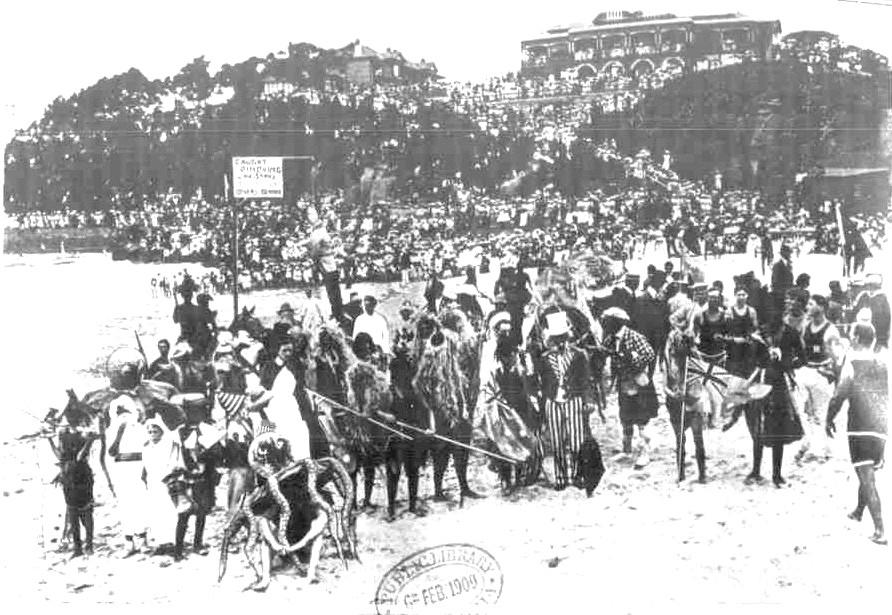
SOME OF THE CARNIVAL CHARACTERS, WITH SPECTATORS IN THE BACKGROUND - VENUS IN HER SHELL BEING CARRIED BY WATER NYMPHS ALONG THE SHORE, THE PROCESSION HEADED BY NEPTUNE. (L C Miller photo (?)). (1909, February 6). The Australasian (Melbourne, Vic. : 1864 - 1946), p. 34. Retrieved from http://nla.gov.au/nla.news-article139688072
A description and report of this February 1909 Surf Carnival:
MANLY SURF CARNIVAL. FINE SPECTACULAR DISPLAY.
Venus was born on Saturday at half-past 2;not this time of ocean foam, but on the smooth water of Manly Cove, where the ferryboats come in, a couple of hundred yards out from the pier. There was a volley from the vessel where her boat lay moored, and the goddess, seated in her hollow shell, was rowed by three or four fantastic figures to the shore. The day was fine, although not over bright, and the stretch of beach was dotted land the piers crowded with hundreds of people came to watch the carnival. At the point where Venus and her crew touched earth a curious procession awaited her. There were Uncle Sam and Neptune, men with dogs' heads and octopuses, a Jack tar and a finely-tattoed Maori, a tribe of prehistoric aboriginals in lampblack, with seaweed garlands and girdles, waving spears and boomerangs, and the old original sea serpent him-self. The whole thing reminded one of- a University- commemoration procession, or some Venetian carnival. Venus in her shell was lifted from the boat; the procession formed about her, and, headed by the Manly Brass Band and fire brigade, they all made through, the crowded streets out upon the ocean beach. Most of the competing surf clubs rolled up strongly, carrying their flags and reels, and so did the Sobraon boys.
The carnival was, on the whole, a great success, but the programme was too long. It began at 2.30, and at 6.30 was hardly over. One result of its length was that there were nearly always two events, athletic and comic, in progress at the same time, so that the spectators' interest was too much divided. The interclub land drill competition, which was held on the raised platform, in full view of the spectators, was won by Bondi after an excellent display. The rescue and resuscitation exhibition by the Sobraon boys also made a good showing. But the platform which had helped these, hindered the other events, which, being conducted below its level, were half hidden to those behind it. The people who were scattered about the centre of the enclosure near the platform, also blocked the line of sight from the deck chairs. The officials persuaded them to sit down on the sand, but there was naturally a lot of popping up and down to change positions and watch now events. The Interclub Alarm and Reel-race, won by Maroubra, and the rescue resuscitation competition, won by Manly A, were exciting, the struggle between Manly and North Steyne being very keen. In a race through the surf, C. N. Smith won from C. Healy, coming in on the top of a wave. During one of the competitions, the tribe of aborigines who had taken part In the procession, and who, together with a crowd of other fantástica, had been playing about the beach during the afternoon, formed in a body, and with shouts and waving of boomerangs, hauled to the edge of the surf a mass of wood like a huge cotton reel, wound round with thick rope. These were the prehistoric life-savers. A muscular savage took the heavy line some distance out, to shouts of laughter, until finally the crowd of them were, or pretended to be, overwhelmed in the surf, from which they hardly rescued their unwieldy reel.
The best of the other events-perhaps the best of all-was Captain Cook's landing. A boat put out from the pilot vessel, pulled by half a dozen sailormen, and, loaded with two antiques in flowing hempen wigs and old-style naval dress. It became evident that Australia was being discovered. The captain and his lieutenant, both of whom were really well got up, marched at the head of the sailors up the beach, to a general scattering of the same prehistoric aborigines (amongst whom were several gins), who had done a turn before. The captain pacified them with paternal gestures, a sailor planted the English flag upon an oar into the sand, and the black, sea-woody figures formed up in a ring round the explorers and the flag, and danced a wild corrobboree. Finally, Captain Cook selected one of the two gins, his lieutenant the second, and they marched off, heading the procession, arm in arm.
The other events included climbing the greasy polo (won by Douglas), a tug of war, a life-saving exhibition by C. W. Purcell a rocket-firing display from the Captain Cook, and surf-boat displays. MANLY SURF CARNIVAL. (1909, February 1). The Sydney Morning Herald(NSW : 1842 - 1954), p. 5. Retrieved from http://nla.gov.au/nla.news-article15032670
As can be seen in these old photos thousands of people attended these early surf displays and carnivals, and thankfully continued to. They were asked to pay a small fee and this money was reinvested back into much needed equipment and development of surf life saving.
Fifteen years later - in February 1925 a report by 'Spartacus Smith, pen name for Alexander Johnson, a wonderful Australian essayist who wrote for the Bulletin, was an Asian correspondent during the Boxer rebellion, adding numerous articles and books to our great Australian newspapers and libraries, outlined how much surf life saving has evolved:
Life- Savers of the Surf - The Rise of the Surf Life-Saving Association of Australia: Its Work and Service
By Spartacus Smith
SEA-BATHING in New South Wales should be a safe enjoyment. Over 4000 splendid young men are sworn to save those who imprudently or accidentally get into difficulties. Life-saving clubs are on the beaches of every port and haven, or if they are not the association will do its best to establish them. The founders claim that Australia leads in this particular branch of social duty. ‘It is the only voluntary humane association of its kind in the world,' they say: 'we have taught, the world how to manage surf-bathing.' Oversea visiting swimmers are astounded to see the work that is done as a patriotic volunteer service in the midst of gay crowds of pleasurers.
When you forget yourself in the delicious exhilaration of the dashing surf and stray outside the lines indicated by the flags, and suddenly that fierce unseen power of the backwash grips you, and you find that your desperate efforts to swim to the beach are not taking you ahead, you will soon see one of the club athletes coming towards you, and quickly rejoice at the feel of a grasp beneath your arms. If you have gone under and under in your clumsy attempts to swim ashore, and the combers have battered the breath out of you until you feel that, it is more pleasant to give in and go to sleep, you will awake on the beach with two or three copper-coloured, sinewy-looking lads rubbing you and pumping your lungs, and find that you, are for once, a brief moment in life's dizzy round, the central figure on the stage, the audience standing in an attentive ring at a respectful distance under the direction of some more of these masterful fellows.. Audience, 1term them, because they will be listening to your grunts as the life-savers bring you back to sensibility, which is then coming to you with a strong taste of salt in your mouth and a belief that you drank most of the ocean in sight. It makes your bathing the pleasanter whenyou go to the seaside to feel that you have your own special corps of athletes watching from the beach. Go down to the sea in confidence, then, and pin your faith, if you and yours are not practised in the ways of the
surf, in the life-savers; they are watching your gambols with the main chance ever in mind. 'The moment- you are in danger signal for help’, the life-savers want you to remember. They take it all in as part of their day's bathing, and you have only to raise your arm; and you will see a bronzed young fellow coming towards you in quick time, and probably enjoying himself at it. Years ago they used to give a medal to a person who saved another from drowning, but these men do it every day. If you are being swept out, don’t struggle and exhaust yourself; just wait till the life-saver comes, and meanwhile make yourself as near an imitation of an elongated lifebuoy as you can. Don’t ask him for '-a -cigarette, but try to throw yourself into the frame of mind in which you could do so if it were possible to light up for the journey home. You then leave the rest to him. If you want to argue matters with this lad, you will find he has his own peculiar way of settling the point at issue.
THE formation of life-saving clubs was a truly sublime idea. It is athleticism in its highest form. Its members must be strong in the best sense of the word, fit to encounter the dangers of heavy seas, with lungs and body in the best condition.
Surfers in excelsis !
Their work devoted to the service of humanity, keeping themselves in the pink of condition, ready for the call. This association is not only on the beaches to yank you out of the water if you should be a victim of the undertow or your own foolhardiness, but to take every possible precaution so that the thousands who go in are bathing in safety. Most of the best swimmers belong to the clubs. Their carnivals and competitions are the sport giving the incentive for clean conditions of body and mind, and keeping so. When bathing in the surf became popular, the rapidly increasing numbers, and the many who knew nothing about swimming, made it apparent that organisation was necessary. These young men banded together lo train and perfect themselves in the work of saving lives. It requires knowledge and stamina. It
TO THE RESCUE!
Reel and line practice on the beach. On the left are the belt-men dashing into the surf with lifeline* attached. The group in the foreground is placing the reel in position.
wants the man with the clear, cool head, and the grip of the quick judge of a position. Members are admitted to membership only after a severe lest of efficiency both in still and rough water. In other words, they must be up to a high standard of physical fitness, adepts and efficients. When admitted to full membership they take up the patrol work on the week-ends and holidays, going on a time-table usually of four-hour spells, relieving each other in squads. Condition has to be maintained, and the carnivals and competitions keep them in training. A great deal has lo be learned by the candidate, in addition to what might be called the method of treating a drowning man and bringing- him buck In life. The beaches have their vagaries. Channels down which the undertow* will go with a rush are formed, currents are to be picked up in certain directions, and so on. The experienced life-saver can often beat the good swimmers by making use of the currents and by knowing how to take the -buffets of the breakers to best effect. Every point is studied by these specialists. The revival method practised is the Schufer, in which the patient is placed face downwards and pressure is put on the lungs, a squeezing, pumping motion just, above, the small of the back, 15 to- the minute, which forces the water out of the lungs, air getting in in its place.
THE reel and line developed quickly. The first thing of the kind used was in a box, in which the rope was coiled. At the meeting convened to form the Bondi Surf-bathers' Life-saving Club early in 1906, the reel apparatus was designed. Experiments were made with a cotton-reel model, and the first one was made by Olding Brothers, at Paddington. It was bigger and somewhat clumsy as compared with the standard now provided. At first a coir rope, was used; then Manila; and finally cotton, and the, reel became what it is to-day. The association standardises all such things. The belt was at first a big cork affair that was cumbersome, and it was brought down to the small one of about two pounds weight now used on the beaches, lately fitted with, a pin holding it together in front, so that if them an with it on finds it necessary he can be freed from the line by pulling out the pin. Another part of the equipment is the tower to be seen on one or two, of the beaches. It has an extension section, so that a considerable height, is obtainable. The function for which it is being mostly used is to enable persons in distress to be easily seen, and also to signal the appearance of the dreaded grey fin out beyond the breakers which tells of the prowling shark.
The surf board is another instrument coming more and more into use. You will see men riding the combers on them, some limes standing upright — like bronzed gods of the surf riding the waves— a fine sight!
The life-savers practise the sport with a view to its becoming one of the valuable instruments of the work. It is now, in fact. Many are skilled with it, and plenty of rescues have been effected when the bathers have been carried beyond the reach of the line, which is 400 yards. One of the proficients is Claud West, of Manly, the permanent man on duty, keeping watch during the week-days when the members are a! their businesses. He has brought in a great many bathers in the last five years, including a Governor-General (Sir Ronald Munn Ferguson, now Viscount Novar), who found himself one day out abreast of the rocks and was helped back. He makes the board extremely useful, and has done some good work with it.. Thus the sport so delightful to watch at the carnivals is removed to the realms of high utility.
The surf boat, now standardised, was constructed from a design by experts on such matters. It is built strongly to fit it for encounter with heavy seas, and some good rescues have, been effected.
They go out beyond the swimming range, when it is found that the reel and line with the human being at the end is unable to reach far enough. The boats are a unique feature in surf life-saving, and they provide the most thrilling spectacles in their races at surf carnivals.
THE association exercises strict control over the clubs and everything connected with the lifesaving. It has a handbook full of instructions from which the members study their drill. The member must not only be able to go out and battle through the big rollers, but if his 'save' has apparently passed over to the Great Beyond (by the passage which is said to be easy and pleasant) he must know how to treat the case and bring it back for more surf-bathing, even though it means some hours spent, with what looks like a corpse. Two hours and more have sometimes been necessary, but success has rewarded the application of knowledge, persistence, and a fine sense of confidence.
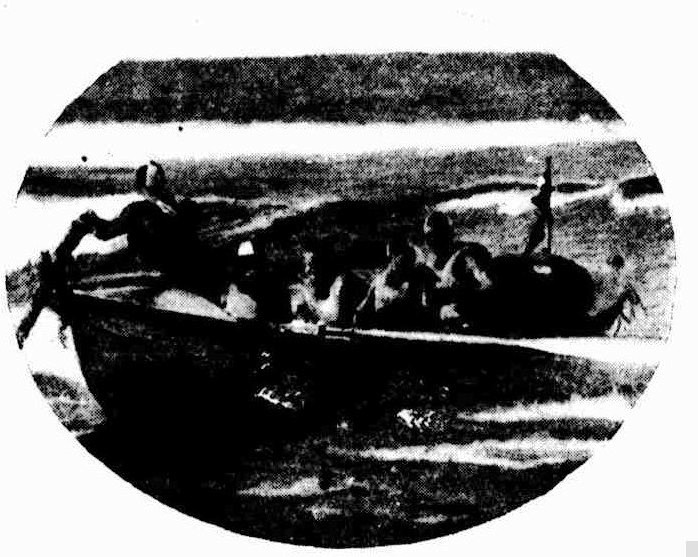
THE SURF BOAT. When bathers get carried too far out for a life-saver to reach them by swimming, the surf boat, specially built for the work, is run into the water and pulled out. A team at practice.
THE efficiency and watchful tirelessness of the lifesaving association's members are shown by the records ; 647 persons were rescued last summer —538 with the line, 23 with the boat, and 86 without line or boat. Over 600 deaths were prevented. Many more were probably unrecorded. The association has the comforting boast for the bathers that while its members have been on patrol no lives have been lost. There is the value of the work of the life-savers ill plain, stark facts. Mr. O. G. H. Merrett, a vice-president, who was manager of the Olympic I cam, said he was satisfied as the result of his observations abroad that the association is the finest organisation of its kind in the world. In its membership are the well-known names of Roy Charlton, Dick Eve, Nick Winter, and Ernest Henry; Jack Chalmers, who tore a lad from the jaws of a shark; Frank Beaurepaire, who went, to his assistance; Boy Chalmers, who swam far out to sea in a raging storm to rescue a girl washed from the rocks at Bondi; Austin Dellit, who, when he saw a shark swimming towards some children playing in the water, dived at it — these are some of the prominent names associated with the membership of this badge of honourable citizenship. The association issues meritorious awards in varying degrees, but they are only given in cases where rescues are attended by exceptional or outstanding rescues.
THERE is now a string of clubs in New South Wales from Point Danger, where the State touches the Queensland border line, to Wollongong on the south. There are 21 clubs in the metropolitan, division, nine in the Northern -district, 11 on the South Coast, 14 on the North Coast. Queensland has seven affiliated with the head centre, and a dozen in New Zealand. The divisions of the association are: Northern, District Branch. Association (Newcastle), the Point- Danger Branch(Tweed Heads, etc.) , the South Coast Branch. (Stanwell Park to South Wollongong). The president is Mr. C. D. Paterson, honorary secretary Mr. Donald McIntyre, hon. treasurer Mr. A. Greville.
A number of doctors are enrolled as honorary medical advisers.' The art of resuscitation, however, is so well studied that a bather can feel assured that, although he may be a long time dead— if he should be. brought in in apparently that condition— he will be receiving expert attention. The association is getting branch clubs established wherever possible, sending instructional teams when opportunity offers. Two are going to the South Coast, in April. The North Bondi Club has to its credit the rescue by two of its members- of Millon Coghlan after his horrible encounter with a shark, in 1922 when he lost his life. The heats of the surf championships were about to begin at Coogee when the shark attacked the youth, and Jack Chalmers, a member of the North Bondi club, assisted by Frank Beaurepaire, swam out and brought the youth in while the shark was lunging at his victim. A magnificent feat, emblazoned on the records of the club. It was superb. There at least was the spirit, if the saving was impossible. Example breeds example, and when, later, the seizure of Mervyn Gannon took place, and, again, a girl had her legs taken off at Bronte, there was no hesitation on the part of bathers to go to the rescue. Since then a shark spear has been designed and perfected for the equipment of the clubs.
THE Surf Life-saving Association first began to be heard of about the year 1908. There was a lifesaving club at Bronte or Bondi in 1906. Bondi is said to have been the first to give an official display of life-saving methods on the beaches. Prior to that no organised arrangements had been made, and the loss of life that occurred raised the question of providing against it. The convention for formation of the Bondi club is said to have originated with Mr. Lyster Ormsby, who had ardent supporters in Major Bond, Messrs. Spencer Dennis and his brother, Rupert O'Brien, Eden Love, the Cravens, and several others. At a meeting convened by Mr. Ormsby the club was formed, and the great reel and line idea came into practical form as the result. Bondi has ever since been a most efficient club, and many younger clubs have benefited by instruction freely given. The association was first the 'Surf-Bathing Association of N.S.W..' afterwards evolving into the 'Surf Life-saving Association of N.S.W.'' to 'the 'S.L.S.A. of Australia.''
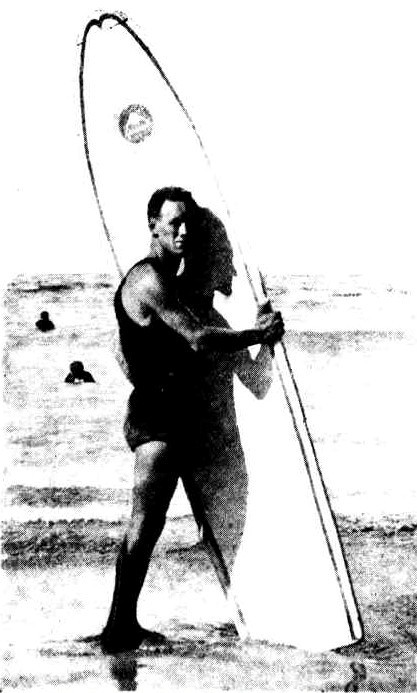
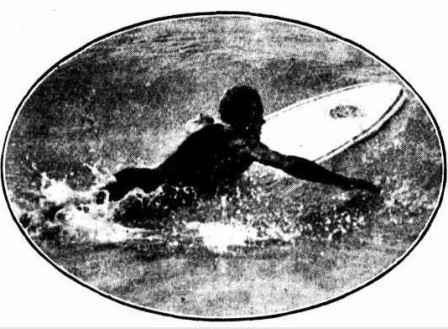
THE SURF BOARD FOR LIFE-SAVING. Claude West, a life-saver stationed at Manly, is an expert in the use of the surf board, which is sometimes used to go out to a bather in distress. The picture on the left (below)shows the swimmer going out; in the other he is coming in with a 'rescue.'
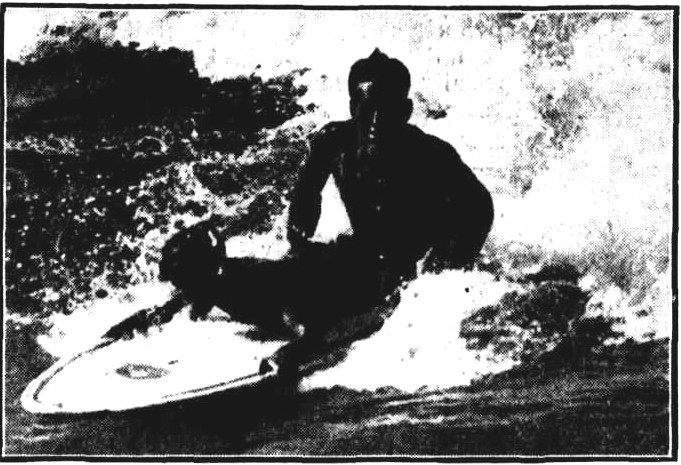
THE actual origination of organised lifesaving is not clear. Mr. Biddell, who invented a cigar shaped lifebuoy for life-saving, is credited by some with having first put forth the idea. The Royal Life Saving Society was in existence, having its headquarters in Britain and much excellent work was to its credit; but the S. L. S. A. branched out with its own scheme, and got its own organisation going. Difficulties about the efficiency examinations and spheres of action were in the way of working together, with the result that, the two have now their respective fields allotted. When the people whose sport was sporting with the big white-topped rollers met to form the Surf-Bathing Association, several clubs having been established, Mr. F. W. J. Donovan, one of the surfers of Manly, and a member of the Manly Club, was chairman, and Mr. Ormsby secretary, Mr. W. H. Cummins treasurer. Mr. G. Daly took Mr. Ormsby's place in 1909. In 1910 15 clubs affiliated; in 1911, 18; in 1913, 26.
AS surfing became popular the Government recognised that it had to take a stand. A commission consisting of M r. J. S. Lord (then president of the Surf-bathing Association ), Mr. Paterson, Mr. J. Garlick (Under-Secretary for Local Government), and Mr. E. M. Allman (metropolitan district engineer) was appointed, which made a complete investigation of the position and made, recommendations, as the result of which £ 17,000 was allotted, and great improvements were made on the beaches in the matter of accommodation and equipment, and in the regulations governing surf-bathing. It was advised that a branch area should be assigned to each club.. The Government money was advanced to the municipal councils to erect the accommodation sheds, without, interest, repayable over a term of years, all of which being revenue-producing eventually repaid the money without any call on the taxpayer. There is an absence of elaboration in the sheds, but the necessary privacy is supplied and the bathers' belongings are left, in safety, as far as practicable. Where the revenue permits, permanent life-savers are retained in addition to the accommodation shed staff. Municipal councils have liberally helped the clubs, though several have asked for practically no assistance at all. The land for the sheds is given or leased. The Government subsidy is £200 per annum, which goes mainly towards defraying some of the cost, of carrying the good work into the country districts where beaches exist.
The rescues officially recorded in 1923-1924 were: —
METROPOLITAN DIVISION'.
With line With boat W'out Line.
Bondi 16 .. — .. 7
Bronte 13 .. — .. 8
Clovelly — — —
Coogee 32 . . — ..5
Cronulla 77 .. 3 .. 5
Deewhy 67 .. 9 .. 1
Freshwater 20 .. 8 ..18
Manly 85 . . — . . —
Maroubra 19 .. — .. —
Mona Vale 6 . . — . . 1
Newport 7 . . — . . 1
North Bondi 61 .. — .. 5
N. Narrabeen 17. . 1 .. 6
North Steyne 22 . . 1 ..6
Palm Beach 15 .. 1 .. 5
Sth. Curl Curl 1 .. — .. —
S. Narrabeen 6 . . — .. —
NORTHERN DISTRICT BRANCH.
Cook's Hill 5 . . — ..—
Merewether 12 . . 2 .. 1
Newcastle 24 .. — .. —
Nobby's 4 . . — . . —
N. Stockton 2
Stockton 2 . . — . . —
Wallarah 1 .. — . . —
NORTHERN RIVERS DIVISION.
Coff's Harbour 3 .. — .. 1
Coff's H. .Jetty 4 . . — ..—
Kempsey Cres- Head 2 .. — .. 1
Cottesloe, W.A. 6 .. — ..2
538.. 23 ..86
The S.L.S.A. has, its headquarters and meeting rooms at the Sydney Sports Club, where the committee meets almost daily to transact business, a tremendous amount of work being necessary in connection with - examinations, carnivals, equipment,' and various other matters, including the despatch of instructional teams to the north and south. Many inquiries come from different parts of the world about, the Australian system, and the propaganda is sent to practically every country in the world where beach-bathing is popular.
TO BE Brought BACK TO LIFE. The work of the Surf Life-Saving Association which is of great value is the art of resuscitation. A team at practice bringing in an apparently drowned man. Life-Savers of the Surf. (1925, February 25). Sydney Mail (NSW : 1912 - 1938), p. 8. Retrieved from http://nla.gov.au/nla.news-article159720700
Claude West (1898 - 1980), apparently taught to surf by Duke Kahanamoku, he may have seen some of the 'surf board shoots' that took place as part of the January 26th Freshwater carnival of 1912, - which was also led by a fancy dress parade - on a board brought back to Australia by Manly's C D Paterson in 1911, or seen the article which appeared later that year in the Sydney Mail or known one Tommy Walker (see Extras):
FRESH WATER SURF CARNIVAL.
The Manly Council has granted permission to the committee of the Freshwater Surf Carnival to conduct a fancy dress procession from the pier along the main street to Freshwater. The carnival will be held on Anniversary Day, and the procession will commence at 1 o'clock. FRESH WATER SURF CARNIVAL. (1912, January 18). The Sydney Morning Herald (NSW : 1842 - 1954), p. 12. Retrieved fromhttp://nla.gov.au/nla.news-article15302947
RIDING THE SURF AT HONOLULU.
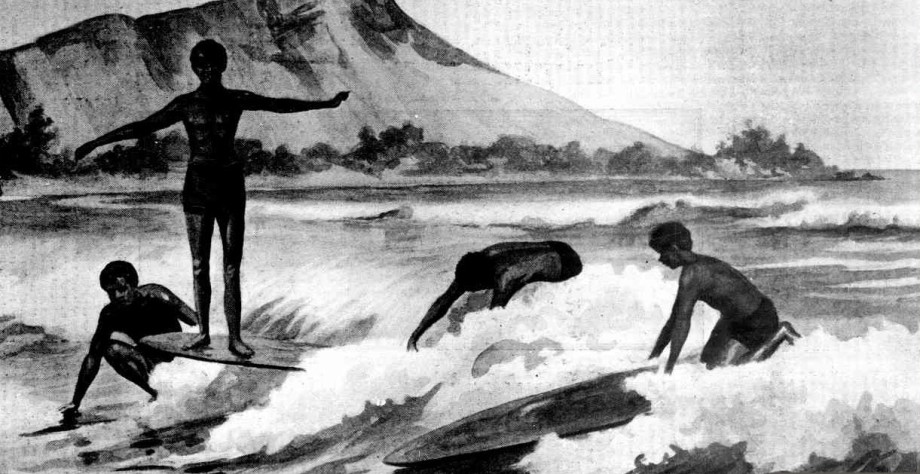
drawn by Agnes Gardner-King — Copyright.
EVERYONE has heard of the surfrriders of Honolulu. Sydney got the idea from the South Sea Islands, but Australians, except on rare occasions, dispense with the board, and 'ride' the waves without artificial aid. Miss Agnes Gardner-King, in contributing the above drawing, writes: — 'The natives take a long pointed board and, after giving it the necessary forward motion to start it on its journey on the crest of the wave, are able to enjoy a delicious ride sitting or even standing on their frail support, till the wave either loses itself or breaks on the beach. The exquisite colouring of the blue water contrasting with the rich brown skins of the natives make the scene a lovely one. Note the proud native turning sideways to receive the plaudits of our little group on the beach.' RIDING THE SURF AT HONOLULU. (1912, December 25).Sydney Mail (NSW : 1912 - 1938), p. 30. Retrieved from http://nla.gov.au/nla.news-article158479458
What is apparent is Mr. West saved lives, thousands of lives, by being a good swimmer, by knowing how to use the equipment, by learning how to great n a surf board and use that as life saving equipment too. He also experienced the worst experience a surf life saver may have to deal with:
DROWNED AT MANLY.
Last Saturday Niel Peter Nielsen, 27, was drowned near North Steyne, Manly, through being caught in the undertow. At an inquiry held on Tuesday by the City Coroner, Alfred Ferns, 10, stated that he and Nielsen were bathing together. The former was carried out about 200 yards, and the boy says that he went out and tried to save him. Messrs. Claude West and Williams went out with a line, and brought the man and the boy in. The boy was all right, but Nielsen did not recover consciousness. A verdict of accidental death was returned. At the request of the relations of the deceased, further evidence as to the accident will be taken on Thursday. DROWNED AT MANLY. (1915, February 24). The Sydney Morning Herald (NSW : 1842 - 1954), p. 12. Retrieved from http://nla.gov.au/nla.news-article15535494
CLAUDE WEST AGAIN.
Claude West, M. Crackanthorp, and Life-Saver Gorman had a busy time last Saturday afternoon. At different times no fewer than 15 bathers were assisted. Claude West, the State Surfboard Champion, has a wonderful record as a lifesaver. To date he has snatched over 1500 from watery graves, including the late Sir Walter Davidson. One of the most thrilling rescues effected on the coast was that brought off by Claude West last Summer at South Steyne, when a youngster, getting into the tow, was whisked seawards. He was perilously close to the rocks and destruction, when West shot out on his surf board, placed the almost drowned boy aboard, and, catching a wave, magnificently landed himself and patient high and dry on the beach. TO DEAL WITH SURF FOOLS. (1923, December 14). Arrow(Sydney, NSW : 1916 - 1933), p. 7. Retrieved from http://nla.gov.au/nla.news-article103542127
And finally, where sports reports meet in the same columns, so too do other local legends, 97 years ago...today:
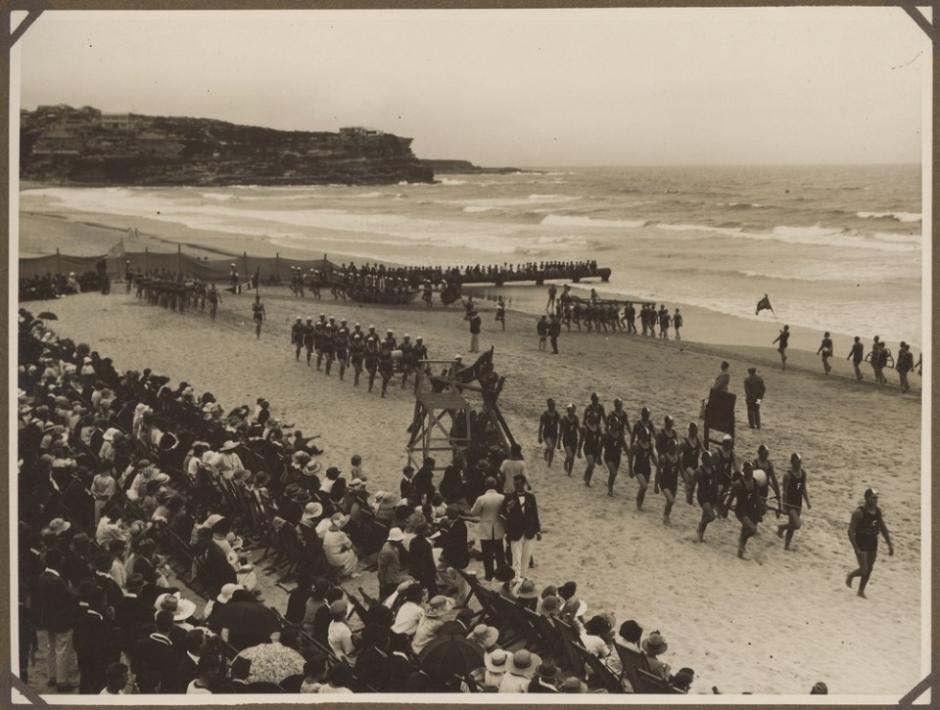
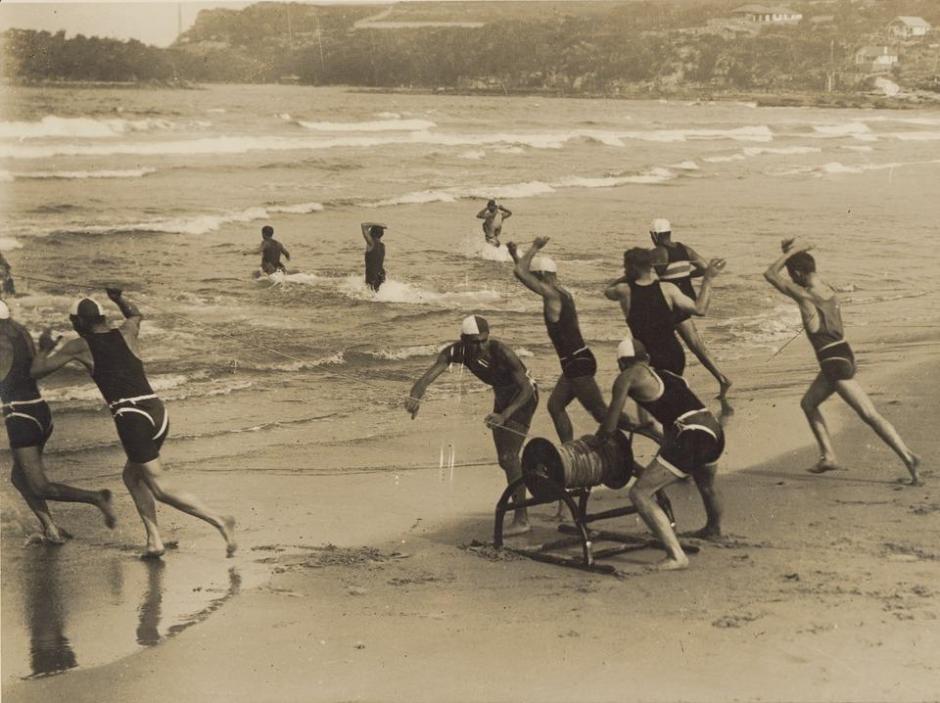
'Parade of Life Saving clubs at a surf carnival: elevated view over seated spectators, lifeguards marching on sand, ocean in background -- A life saving rescue race, three competing teams, Feb. 1928 Manly Carnival: men at water's edge running out the life line -- Bringing in a member of a team who collapsed during a race, same carnival, men carrying another man out of the water, face down -- Showing how a rescue surfer is brought in: carrying a man over the sand, face down. '
Author/Creator: Gladys E Moss 1900-1950, Sydney Mail, photographer. Images courtesy State Library of Victoria., No.s: H2010.190/29, H2010.190/30, H2010.190/31 and H2010.190/32
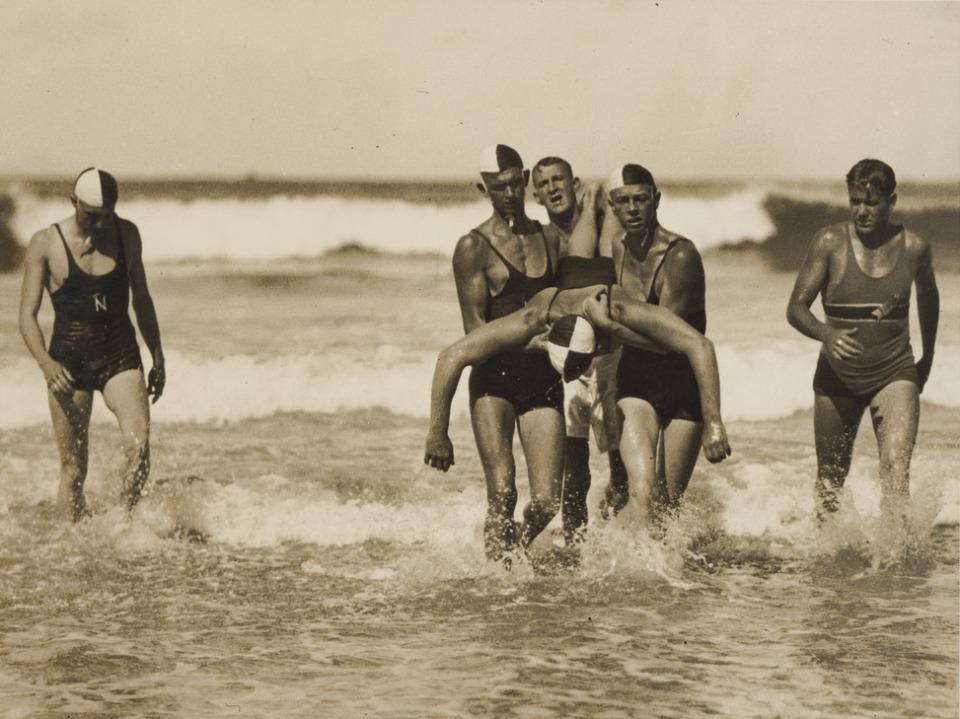
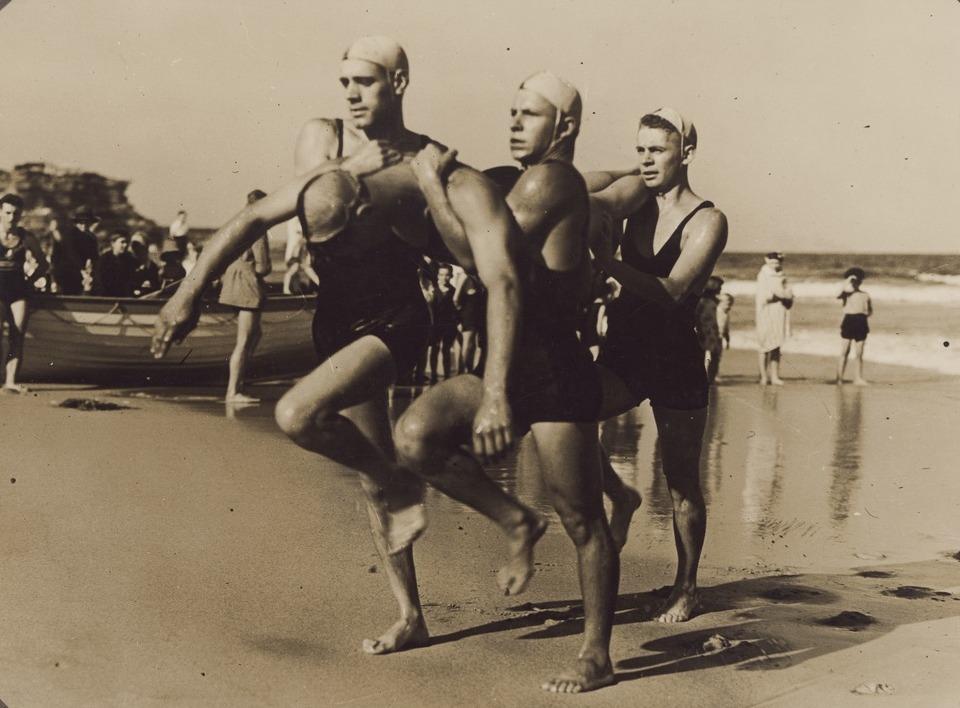
Extras:
See Surf Bathing and the Advent of Manly’s First Surf Carnival - 1907 - Issue 125, 2013
GALLANT RESCUE FROM DROWNING,
The thousands of excursionists who visited Manly yesterday afternoon witnessed the narrow escape of a boy named William Grey, who resides in Victoria-street, Waterloo, and who is about 15 years of age, from death by drowning, and a gallant rescue. The boy, who was bathing on the beach, got beyond his depth, and was carried out a couple of hundred yards past the breakers. Mr George Moore, of Willoughby, who is staying at the Clarendon Hotel, and Mr. John Kerr, another Manly resident, ran out a life-line, and, plunging into the surf, went to the lad's assistance. They succeeded in bringing him to shore, but only after a struggle of about 20 minutes duration, at the conclusion of which they were heartily applauded for their plucky conduct. GALLANT RESCUE FROM DROWNING. (1902, December 27).Evening News (Sydney, NSW : 1869 - 1931), p. 4. Retrieved from http://nla.gov.au/nla.news-article114503699
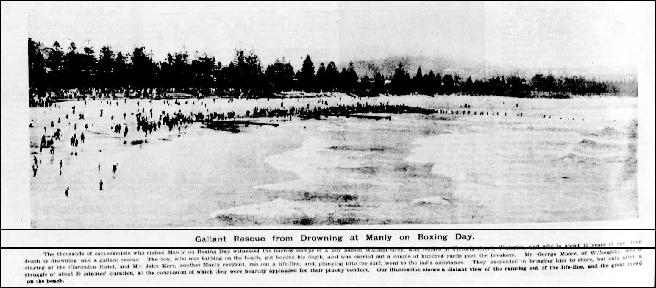
Pic: Gallant Rescue from Drowning at Manly on Boxing Day. (1902, December 31). Australian Town and Country Journal (NSW : 1870 - 1907), p. 26. Retrieved from http://nla.gov.au/nla.news-article71496924
Dangers of the Surf
NARROW ESCAPE AT MANLY.TWO BATHERS NEARLY DROWNED.
Manly was within an ace this morning of having to add another to its list of bathing fatalities, two persons having a narrow escape of being carried out to sea. They were rescued with a line. Particulars are meagre, but inquiries at the local Council Chambers go to show that two bathers, one a man and the other a lad, whose names have not yet been ascertained, were bathing at Cabbage Tree Beach, some distance from the regular dipping place. There the undertow is very deadly, and bathers have been repeatedly warned against venturing in there. The lad, it is stated, got into difficulties, and the man went to his rescue. He got in the grip of the undertow, and both their positions became very critical. Here it was that Edward Eyre, the Life Saving Society's official, who does duty on the beach, came to the rescue. Seeing the bathers in difficulties, he took a line out, and succeeded in bringing both bathers ashore in safety. Dangers of the Surf. (1906, January 4). Evening News (Sydney, NSW : 1869 - 1931), p. 5. Retrieved from http://nla.gov.au/nla.news-article114222385
BENEFIT TO A LIFE-SAVER.
The one-time prominent footballer, Edward(''Happy') Eyre, who has (on the ocean beach at Manly), during the past couple of years, rescued a large number of people from watery graves, is to be benefited by surf-bathers and residents generally of the ocean-side suburb, in recognition of his pluck and humane deeds. At the present time 'Happy' Eyre is 'beach custodian' at Manly. Our source of information does not disclose the date of the benefit, but it will probably take place within the next few weeks. BENEFIT TO A LIFE-SAVER. (1906, January 28). Sunday Times(Sydney, NSW : 1895 - 1930), p. 8. Retrieved from http://nla.gov.au/nla.news-article126557439
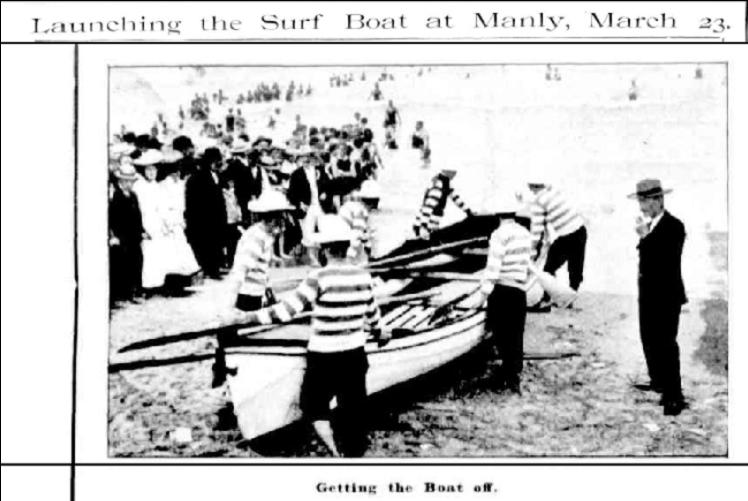
Launching the Surf Boat at Manly, March 23. (1907, March 27).Australian Town and Country Journal (NSW : 1870 - 1907), p. 20. Retrieved from http://nla.gov.au/nla.news-article71590669
SURF BATHING. A meeting of surf bathers, convened for the purpose of forming a club, the objects of which are to organise surf bathers to obtain suitable dressing-rooms and improvements at Manly, and to assist in improved life-saving methods, etc, will be held at the Steyne Hotel, Manly, on Tuesday next. SURF BATHING. (1907, July 15). The Sydney Morning Herald(NSW : 1842 - 1954), p. 11. Retrieved from http://nla.gov.au/nla.news-article14834176
Tommy Walker Says— 'I Brought First Surfboard To Australia'
IN a letter to Harry M. Hay, Australia’s foremost swimming and, surf coach, Tommy Walker, one-time surfboard champion at Manly (N.S.W.), writes: 'I saw an article by you in 'The Referee' re surfboards. so enclose a photo of myself and surfboard taken in 1909 at Manly. This board I bought at Waikiki Beach, Hawaii, for two dollars, when I called there aboard the 'Poltolock.' I won my first surfboard shooting competition at Freshwater carnival back in 1911,and that wasn't yesterday. Regards.'
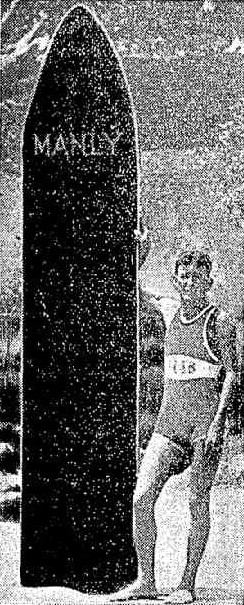 Walker was a well-known figure at Manly at the time he writes about. He figured in a couple of unusual, if not remarkable, incidents.
Walker was a well-known figure at Manly at the time he writes about. He figured in a couple of unusual, if not remarkable, incidents.
Time came when Tommy decided to catch a shark for the purpose of exhibiting it to the public at threepence a head. He brought three other lads into the enterprise and between them they raised the necessary capital to buy a hook and line and to hire a tent in which to install the monster of the deep. But first they 'had 'to catch their fish. They selected Fairy. Bower beach as their base and set a watch on the hill overlooking it. On the second day of their vigil, the required shark was sighted. Like a policeman on his beat, he came leisurely from the direction of South Steyne. And he was a Whopper, a tiger, 14ft 2in in length, as was proved later. He was duly landed struggling on the beach and a curious public had paid £12/10/to view him when the Council's inspector of nuisances intervened to the manifest relief of the residents in the vicinity. But one may ask, 'Where' does the hero stuff come in?' Well, it was this way. When the shark was sighted, the watchers on the. Hill signalled to Tommy (who was waiting on the' beach) and he immediately set out in a small dinghy to drop the bait at the spot it was anticipated the shark would cross. The craft capsized. So Tommy swam with the bait, a -7lb salmon, and literally spilt it into the shark's mouth. The shark grabbed it— and the rest was easy. Someone said, 'I ..wouldn't have done that for £10,000.' ..Tommy replied simply, .''There was no danger — when salmon are about, a shark has no time for anything else.'
IN the other incident Ivay Schilling was the heroine. She Will be recalled as J. C. Williamson's principal dancer. The company was having a successful season at the Theatre Royal. A strong swimmer, she was surfing at South Steyne one morning, when only two others were in the water. Walker was one of them. Miss Schilling had crossed a deep channel and was resting on a sandbank, and was watching Walker shooting. He could swim like a fish. This was at a time when large surfboards were unknown in Australian waters. However, Walker did not need any adventitious aids when shooting, at which he was one of the recognised adepts. It was impracticable, however, to shoot right into the sand because of the channel, which banked the surf up. After his third shoot, Walker appeared to be in sore trouble in the channel. His scream for help galvanised the dancing star into action. -With powerful strokes, swimming trudgeon style, she quickly covered the necessary 30 yards to reach the youth who was sinking for the third time. He appeared to 'be- in a fit- and struggled violently as the gallant lady swam with him to' the shore.
JUST at this moment the professional lifesaver, the late 'Appy Eyre, arrived and he worked on the unconscious form of Walker, who, when he came to his senses, ejaculated, ''Well, that is the last time I'll go surfing immediately after' a heavy' breakfast.' ?
TOMMY WALKER
The evening papers rang with the story, and the performance at the Royal was held up that night when Miss Schilling appeared on the stage. Members of the audience from all parts of the theatre rose and cheered, and cheered, and cheered again. And Tommy — what of him? Just about that time, a week beforehand, in fact, Claude Eric Ferguson McKay had been appointed to the position as Williamson's publicity man. 'Walker, if unwittingly, had brought one of Williamson's stars into the limelight— had given her the opportunity of appearing as a heroine in a drama off the stage. McKay was delighted. He presented Walker with a brand new £5 note. Tommy Walker Says—. (1939, February 23). Referee (Sydney, NSW : 1886 - 1939), p. 16. Retrieved from http://nla.gov.au/nla.news-article127604199
DEE WHY CARNIVAL. KAHANAMOKU AND HIS SURF BOARD.
D. P. Kahanamoku, the famous Hawaiian swimmer, gave an exhibition on the surf board at the Dee Why surf carnival on Saturday. The beach was lined with people, all anxious to obtain a good view. The various events were watched with interest, especially the performance of Kahanamoku. He came out with his surf board, plunged into the water and continued to swim out until those watching from the beach wondered when he would stop. After covering nearly half a mile, Kahanamoku turned and prepared for a roller, which came along a moment after ; he caught it, and as the wave carried him shorewards he performed all kinds of acrobatic feats on the board, and finally dived into the water as the roller broke. The crowd showed their appreciation in a very hearty manner. Kahanamoku remained in the surf for nearly an hour, and he was accompanied at intervals by Miss Letham, of Freshwater, and it was a rare sight to watch both swimmers on the surf board.
The various surf events under the control of the New South Wales Surf Bathing Association were well contested. An open-air concert at night concluded the day's sport. Details :—
Grand Parade of Clubs.—Dee Why, 1 ; North Steyne, 2.
Three-legged Race.—North Steyne, 1 ; Collaroy, 2.
Pennant Rescue and Resuscitation Competition.— Metropolitan Division, third round ; Bondi A, 57.77points, 1 ; Manly A, 57.47 points, 2 ; Coogee, 56.66points, 3 ; North Steyne, 52.03 points, 4.
Novice Surf Race.—A. V. Rein (Manly), 1 ; C. D. Bell (Manly), 2.
Tug-of-War.—Collaroy, A. L. Melrose, capt. ; C. Knight, J. Walton, A. Thew, J. Jack, J. Bloomfield, D. Scully), 1.
Beach Relay Race.—First heat : Collaroy, 1. Second heat : North Steyne, 1. Third heat : Coogee, 1. Final :Collaroy (L. Chinchen, T. V. Smith, A. Sheldon, L. Sheldon), 1 ; North Steyne (E. Goulding, G. Morgan,O. H. G. Merrett, C .Whitehead), 2.
Alarm Reel Race.—Manly (H. M. May, belt, O. Mater, H. Buhl, F. Bennett, D. West), 1 ; NorthSteyne (L. Hind, belt, F. Nicholls, B. McEwan, E. Goulding, N. Thompson), 2.
Cock Fight.—Balmoral ( J. Doudney, C. Walker), 1.Surf Brace Relay Race.—Manly (J. Brown and N. Smith), 1 ; North Steyne (C. Healy, L Solomon), andBondi (J. G. Brown and H. Fletcher), dead heat.
Novice Alarm Reel Race.—First heat : North Steyne,1 ; North Bondi, 2. Second heat : Coogee, 1. Thirdheat : Bondi, 1. Final : Coogee (J. Leary, H. Mason,H. McClure, R. Harret, M. Reubenstein), 1.
Wheelbarrow Race.—North Steyne (H. Nicholls, F. E. Nicholls), 1. DEE WHY CARNIVAL. (1915, February 8). The Sydney Morning Herald (NSW : 1842 - 1954), p. 13. Retrieved from http://nla.gov.au/nla.news-article15549791
Manly Surf Carnival and Other Topical Events
WINNERS OF THE MARCH - PAST AT THE MANLY CARNIVAL.
The North Narrabeen team, whose long list of victories was interrupted In defeat at Freshwater on Anniversary Day, won the march-past at the Manly Carnival on Saturday. There were fifteen competing teams. North Bondi was second, and Coogee third. Manly Surf Carnival and Other Topical Events. (1928, February 1). Sydney Mail (NSW : 1912 - 1938), p. 42. Retrieved from http://nla.gov.au/nla.news-article158399334
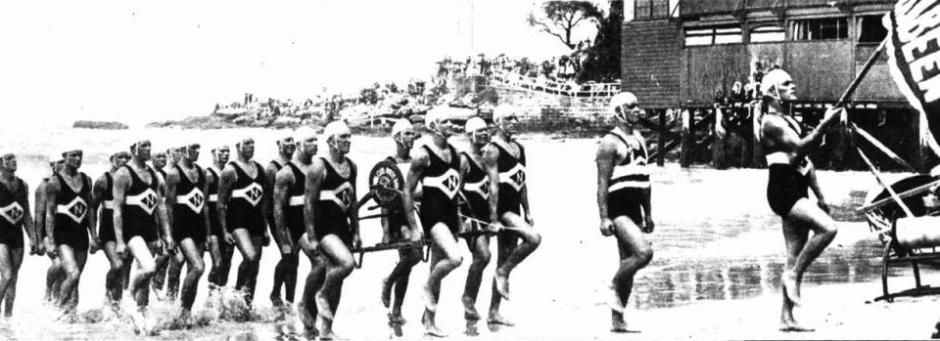
A Glance at Surf Carnivals in February 1909, 1919, 1925, a Fancy Dress Rise of Venus and Saving Lives with Surfboards - threads collected and collated by A J Guesdon, 2016.